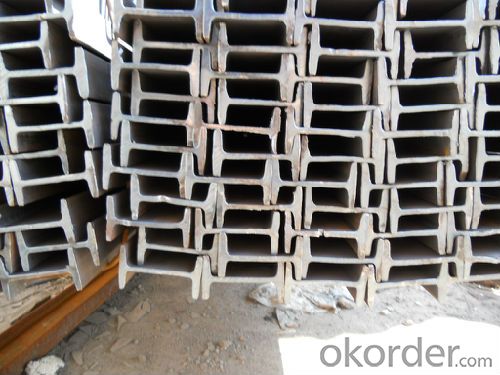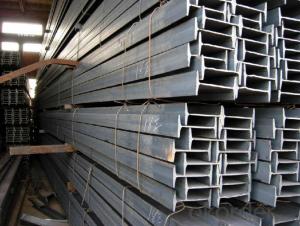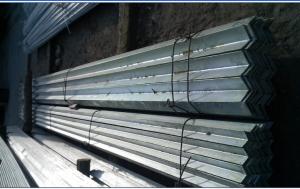HR Steel I Beams with High Quality for Sale
- Loading Port:
- China main port
- Payment Terms:
- TT or LC
- Min Order Qty:
- 25 m.t.
- Supply Capability:
- 100000 m.t./month
OKorder Service Pledge
OKorder Financial Service
You Might Also Like
Product Description:
Production Standard: GB Standard, EN10025, DIN, JIS, etc.
Material of Steel I-Beam: Q235,SS400,A36,ST37-2,S235JR
Length: 5.8M, 6M, 9M, 12M or as the requriements of the clients
Sizes: 80MM-270MM
Section | Standard Sectional Dimensions(mm) | ||||
h | b | s | t | Mass Kg/m | |
IPE80 | 80 | 46 | 3.80 | 5.20 | 6.00 |
IPE100 | 100 | 55 | 4.10 | 5.70 | 8.10 |
IPE120 | 120 | 64 | 4.80 | 6.30 | 10.40 |
IPE140 | 140 | 73 | 4.70 | 6.90 | 12.90 |
IPE160 | 160 | 82 | 5.00 | 7.40 | 15.80 |
IPE180 | 180 | 91 | 5.30 | 8.00 | 18.80 |
IPE200 | 200 | 100 | 5.60 | 8.50 | 22.40 |
IPE220 | 220 | 110 | 5.90 | 9.20 | 26.20 |
IPE240 | 240 | 120 | 6.20 | 9.80 | 30.70 |
IPE270 | 270 | 135 | 6.60 | 10.20 | 36.10 |
IPEAA80 | 80 | 46 | 3.20 | 4.20 | 4.95 |
IPEAA100 | 100 | 55 | 3.60 | 4.50 | 6.72 |
IPEAA120 | 120 | 64 | 3.80 | 4.80 | 8.36 |
IPEAA140 | 140 | 73 | 3.80 | 5.20 | 10.05 |
IPEAA160 | 160 | 82 | 4.00 | 5.60 | 12.31 |
IPEAA180 | 180 | 91 | 4.30 | 6.50 | 15.40 |
IPEAA200 | 200 | 100 | 4.50 | 6.70 | 17.95 |
Usages:
According to the needs of different structures, steel I-beam can compose to different force support component, and also can be the connections between components. They are widely used in various building structures and engineering structures such as roof beams, bridges, transmission towers, hoisting machinery and transport machinery, ships, industrial furnaces, reaction tower, container frame and warehouse etc.
Packaging & Delivery :
1. Packing: it is nude packed in bundles by steel wire rod
2. Bundle weight: not more than 3.5MT for bulk vessel; less than 3 MT for container load
3. Marks:
Color marking: There will be color marking on both end of the bundle for the cargo delivered by bulk vessel. That makes it easily to distinguish at the destination port.
Tag mark: there will be tag mark tied up on the bundles. The information usually including supplier logo and name, product name, made in China, shipping marks and other information request by the customer.
If loading by container the marking is not needed, but we will prepare it as customer request.
4. Transportation: the goods are delivered by truck from mill to loading port, the maximum quantity can be loaded is around 40MTs by each truck. If the order quantity cannot reach the full truck loaded, the transportation cost per ton will be little higher than full load.
5. Delivered by container or bulk vessel
6. Delivery time: All the structural steel I beams will be at the port of the shipment within 45 days after receiving the L/C at sight ot the advance pyment.
7. Payment: L/C at sight; 30% advance payment before production, 70% before shipment by T/T, etc.
Production flow:
Material prepare (billet) —heat up—rough rolling—precision rolling—cooling—packing—storage and transportation
FAQ:
Q1: Why buy Materials & Equipment from OKorder.com?
A1: All products offered byOKorder.com are carefully selected from China's most reliable manufacturing enterprises. Through its ISO certifications, OKorder.com adheres to the highest standards and a commitment to supply chain safety and customer satisfaction.
Q2: How do we guarantee the quality of our products?
A2: We have established an advanced quality management system which conducts strict quality tests at every step, from raw materials to the final product. At the same time, we provide extensive follow-up service assurances as required.
Q3: How soon can we receive the product after purchase?
A3: Within three days of placing an order, we will begin production. The specific shipping date is dependent upon international and government factors, but is typically 7 to 10 workdays.
Images:


- Q:What is the GB tolerance of I-beam?
- The allowable deviation of + 0.06t 1, the average thickness of steel legs.2. The bending deflection of I-beam should not exceed 0.15d.The outer edge of the slope 3, I-beam legs, one leg is not greater than 1.5%b, not more than 2.5% legs.4, steel legs, shoulder passivation shall not be equal to 0.18T diameter of the round bar through.
- Q:Can steel I-beams be used for elevated walkways or bridges?
- Yes, steel I-beams can be used for elevated walkways or bridges. Steel I-beams are commonly used in construction due to their strength and structural integrity. They are designed to bear heavy loads and provide stability, making them ideal for applications such as walkways or bridges. The I-beam shape allows for greater weight distribution and resistance to bending or buckling. Additionally, steel is a durable material that can withstand harsh weather conditions and requires minimal maintenance. Therefore, steel I-beams are a popular choice for constructing elevated walkways or bridges, ensuring the safety and reliability of these structures.
- Q:What are the different types of steel I-beam supports?
- The different types of steel I-beam supports include standard I-beams, wide flange beams, and H-beams. These supports are designed to provide structural stability and load-bearing capacity in various construction and engineering applications.
- Q:Can Steel I-Beams be used for soundproofing purposes?
- No, Steel I-Beams are not typically used for soundproofing purposes. They are primarily structural components and do not have the necessary properties to effectively block or absorb sound. Soundproofing typically involves using materials specifically designed for noise reduction, such as acoustic insulation, sound barriers, or sound-absorbing panels.
- Q:Can steel I-beams be used in modular construction?
- Yes, steel I-beams can certainly be used in modular construction. Modular construction refers to the process of building structures off-site in a controlled environment, with various components being prefabricated and then assembled on-site. Steel I-beams are commonly used in this type of construction due to their strength, durability, and versatility. Steel I-beams have high load-bearing capabilities, making them ideal for supporting heavy loads in modular construction. They can be used as structural elements for both horizontal and vertical applications, such as floor joists, roof trusses, and support beams. Additionally, their uniform shape and standardized sizing make them easily integrated into modular construction systems. Moreover, steel I-beams offer several advantages in the context of modular construction. They are lightweight compared to other construction materials, which reduces transportation costs and allows for easier assembly on-site. Steel is also highly resistant to various environmental factors, such as fire, corrosion, and pests, ensuring long-term durability and safety of the modular structure. Furthermore, steel I-beams can be designed and manufactured to precise specifications, allowing for efficient and accurate assembly during modular construction. They can be easily interconnected with other modular components, ensuring a strong and stable structure. Additionally, steel I-beams can be customized to accommodate specific architectural and design requirements, making them suitable for a wide range of building types and styles. In conclusion, steel I-beams are commonly used in modular construction due to their strength, durability, versatility, and numerous advantages. Their load-bearing capabilities, lightweight nature, resistance to environmental factors, and ability to be customized make them an excellent choice for integrating into modular construction systems.
- Q:Can steel I-beams be used in stadium construction?
- Yes, steel I-beams can be used in stadium construction. In fact, steel I-beams are commonly used in the construction of stadiums due to their strength and versatility. They provide structural support and can withstand heavy loads, making them ideal for large-scale projects like stadiums. Additionally, steel I-beams can be customized and fabricated to meet the specific design and architectural requirements of the stadium, ensuring a safe and efficient construction process.
- Q:What are the common methods of protecting steel I-beams from corrosion?
- There are several common methods of protecting steel I-beams from corrosion. One widely used method is applying a protective coating such as paint or epoxy. This creates a barrier between the steel and the surrounding environment, preventing moisture and corrosive substances from reaching the surface of the beams. Another method is hot-dip galvanizing, where the steel beams are coated with a layer of zinc. This zinc coating acts as a sacrificial layer, corroding instead of the steel when exposed to corrosive elements. Additionally, cathodic protection, which involves using sacrificial anodes or impressed current systems, can be employed to protect steel I-beams from corrosion by creating a protective electrical current that prevents the steel from corroding.
- Q:What are the different types of steel I-beam support systems?
- There are several different types of steel I-beam support systems commonly used in construction and structural engineering. Some of the most common types include: 1. Rolled I-Beams: These are the most basic and commonly used type of I-beam support systems. They are manufactured by rolling steel plates into the shape of an I-beam, with varying dimensions and load-bearing capacities. 2. Welded I-Beams: These support systems are created by welding together two or more rolled I-beams to form a larger and stronger beam. This method allows for the creation of customized I-beams with specific load-bearing capacities. 3. Composite I-Beams: Composite I-beams are made by combining different materials, such as steel and concrete, to create a stronger and more rigid support system. The combination of materials enhances the overall load-bearing capacity and structural integrity of the I-beam. 4. Box Girders: Box girders are similar to I-beams in shape but have a rectangular or box-like cross-section. They are commonly used when larger load-bearing capacities and longer spans are required. Box girders can be made from steel plates or by welding together multiple sections. 5. Tapered I-Beams: Tapered I-beams have a varying depth along the length of the beam, allowing for more efficient load distribution and weight reduction. These support systems are often used in structures with complex or irregular load requirements. 6. Light-gauge steel I-beams: Light-gauge steel I-beams are made from thinner steel plates and are commonly used in residential construction and smaller-scale projects. They are lighter and easier to handle, but have lower load-bearing capacities compared to heavier-gauge I-beams. These are just a few examples of the different types of steel I-beam support systems. The choice of which type to use depends on factors such as the specific load requirements, span length, and overall structural design of the building or project. It is important to consult with a structural engineer or construction professional to determine the most suitable type of I-beam support system for a particular application.
- Q:Can steel I-beams be used in historical building preservation projects?
- Yes, steel I-beams can be used in historical building preservation projects. Steel I-beams are often used as structural support elements in buildings due to their high strength and durability. When it comes to preserving historical buildings, it is important to balance the need for structural integrity with maintaining the original aesthetic and historical value. In many cases, using steel I-beams can help reinforce and stabilize the building, ensuring its longevity while still preserving its historical significance. Additionally, steel I-beams can be concealed within the structure or integrated into the design in a way that minimizes their visual impact on the building's historic features. Ultimately, the use of steel I-beams in historical building preservation projects should be carefully considered and evaluated on a case-by-case basis to ensure the best outcome for both structural stability and preservation of the building's architectural heritage.
- Q:What are the common maintenance requirements for steel I-beams?
- To keep steel I-beams in good condition, it is necessary to perform regular maintenance tasks such as cleaning, inspecting for corrosion or damage, and occasionally repainting. Cleaning should involve removing any accumulated dirt, dust, or debris from the surface using a mild detergent, water, or a specialized steel cleaner. It is important to avoid using abrasive cleaners or tools that could harm the steel's protective coating. Regular inspection is crucial to identify any signs of corrosion or damage. This can be done by visually examining the I-beams for rust, cracks, or deformities. If any issues are found, they should be promptly addressed to prevent further deterioration. Small rust areas can be treated by removing the rust and applying a rust inhibitor. However, if there is extensive corrosion or structural concerns, it is advisable to seek professional help for repairs. In addition, occasional repainting may be necessary to maintain the appearance and protection of steel I-beams. Over time, the steel's protective coating can wear off or become damaged, increasing the risk of corrosion. Repainting involves thorough cleaning, removing loose paint or rust, and applying a new coat of paint or protective coating. The frequency of repainting depends on environmental conditions and the quality of the initial coating. In summary, steel I-beams require regular cleaning, inspection, and occasional repainting to ensure their longevity and the safety of the structure they support. Proper maintenance of these structural components is essential for their continued functionality and integrity.
1. Manufacturer Overview |
|
|---|---|
| Location | |
| Year Established | |
| Annual Output Value | |
| Main Markets | |
| Company Certifications | |
2. Manufacturer Certificates |
|
|---|---|
| a) Certification Name | |
| Range | |
| Reference | |
| Validity Period | |
3. Manufacturer Capability |
|
|---|---|
| a)Trade Capacity | |
| Nearest Port | |
| Export Percentage | |
| No.of Employees in Trade Department | |
| Language Spoken: | |
| b)Factory Information | |
| Factory Size: | |
| No. of Production Lines | |
| Contract Manufacturing | |
| Product Price Range | |
Send your message to us
HR Steel I Beams with High Quality for Sale
- Loading Port:
- China main port
- Payment Terms:
- TT or LC
- Min Order Qty:
- 25 m.t.
- Supply Capability:
- 100000 m.t./month
OKorder Service Pledge
OKorder Financial Service
Similar products
New products
Hot products
Hot Searches
Related keywords




























